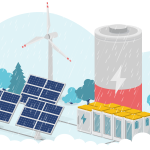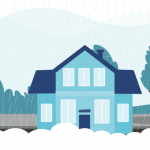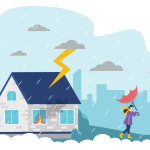How Climate Change is Shaping Home Insurance
May 1, 2025

Climate change is no longer a distant concern; it’s here, and it’s affecting everything from our weather patterns to our daily routines to how we protect our homes. Intense storms, prolonged droughts, and devastating wildfires are more frequent and unpredictable than ever before. As these climate risks show no signs of slowing down, insurance companies are being forced to rethink what it truly means to cover a home.

The reality is: climate change is more than an environmental issue—it’s a financial one, with huge consequences for homeowners and insurers alike. Keep reading to learn more about how climate-related risks are shaping the Home Insurance landscape, and what you can do to stay informed, protected, and proactive.
How do climate risks affect Home Insurance?
As climate change fuels more extreme weather events, like floods, wildfires, storms, and heatwaves, insurers are being forced to adapt. Here’s what that means for you as a homeowner:
1. Increased Claim Frequency
Climate-related weather events are happening more often and with greater force than ever before. Homes are now more likely to experience weather-induced property damage, such as:
- Water damage from flash floods or rising water levels;
- Structural damage from high winds or hail; and
- Significant loss in severe wildfire zones.
Not only do these events create stress and disruption for the homeowners affected—they’re also driving a surge in costly insurance claim payouts. In fact, the Insurance Bureau of Canada reported $8.5 billion in severe weather-related losses in 2024, nearly tripling the total from 2023 and far surpassing the previous record of $6 billion set in 2016. Even those who haven’t filed a claim are feeling the impact of this ripple effect, as the entire insurance market adjusts to a more volatile climate.
RELATED: How Does Your Claims History Affect Your Home & Auto Insurance?
2. Higher Insurance Premiums
Insurers calculate premiums based on risk—and thanks to climate change, that risk is on the rise. To offset the cost of losses from weather-related claims, insurers have no choice but to raise their premiums. Additionally, the increased demand for repairs after disasters, combined with inflation and supply chain issues, translates into higher rebuilding costs—a 66% raise since 2019, to be exact—and in turn, higher insurance costs.
If your home is located near a floodplain, wildfire zone, or coastline, it’s no surprise that you could see even more significant premium hikes. More insurance companies are also revising their risk models to account for the new realities of climate change and more accurately assess long-term risks. That means even if your area was once considered low-risk, it might not stay that way as climate zones are continuously shifting—and insurers may even preemptively raise premiums to prepare for future losses.
RELATED: 10 Factors That Affect Your Home Insurance Premiums
3. Reduced Coverage
As severe weather events become more common, it’s important to remember that not every risk is covered under a standard Home Insurance policy. Flood coverage, for example, has traditionally been excluded from standard coverage and must be purchased separately.
With climate change increasing the likelihood of certain disasters, higher-risk regions may see insurers adapting to climate risk by raising deductibles, excluding area-specific perils or imposing stricter coverage limits—leaving homeowners with less protection and higher out-of-pocket expenses. In extreme cases, those who are unable to secure affordable Home Insurance with major providers may be forced to turn to more expensive solutions that offer less flexibility.
RELATED: Severe Weather Events: Is Your Home Covered?
What can you do?
In the face of climate change, here are some proactive steps you can take to better protect your home—and your wallet:
1. Review your coverage regularly.
Don’t wait for a disaster to discover a coverage gap! Always read the fine print of your policy—weather-related damage might not be covered unless you’ve added specific endorsements, such as overland flooding, sewer backup, earthquakes, landslides or even wildfires in high-risk areas. And keep in mind that high-value items like jewelry, art, or electronics may also require separate endorsements to be fully protected in case of loss or damage.
The value of your home and its contents has likely changed over time, especially if you’ve completed any renovations or purchased any valuables. So as a general rule, take the time to review your Home Insurance at least once a year, making sure that it reflects the current rebuilding costs and includes adequate protection against climate-related risks you might face—including temporary housing if you ever need to evacuate your home. When in doubt, ask your insurer about any add-ons that you might be missing.
RELATED: 4 Signs Your Home May Be Underinsured
2. Take steps to mitigate the risk.
Taking the right preventative measures will help manage your risk of climate-related damage, with some insurers even offering incentives for certain upgrades! Consider installing:
- Sump pumps or backwater valves to reduce the risk of sewer backups and basement flooding.
- Fire-resistant roofing and siding, especially if you live near a wildfire zone.
- Storm shutters or impact-resistant windows to prevent costly damage from heavy winds and storms.
- Smart water sensors that alert you to leaks early can reduce the likelihood of a costly claim—and the good news? PROLINK has partnered with Eddy Solutions, an industry leader in water management technologies. Eddy’s smart water sensors provide immediate notification of a possible leak, automatic and remote shutoff, and 24/7 monitoring through their mobile app.
Additionally, homeowners should remain diligent about property maintenance to stay resilient against the weather. Climate change brings more intense heat and moisture, which can wear down building materials faster—leading to more frequent and expensive home repairs. For example, basements may sustain more water damage, foundations may shift or crack with changes in soil moisture, and roofs may need replacing sooner rather than later. Increased moisture can also attract pests, and standard Home Insurance won’t cover infestations.
RELATED: How to Storm-Proof Your Home
3. Stay informed.
Understanding your home’s exposure to climate-related threats is the key to staying protected. Use tools like flood maps, wildfire risk assessments, or local hazard indexes to help guide your insurance decisions and identify areas where mitigation efforts are most needed. This is especially important if you’re considering buying property—climate risk should be part of the conversation from day one of the house hunt.
As risks evolve, so do insurance products, coverage options, and even government programs. Staying up-to-date on climate-related news in your area can help you make smarter choices for the long term, insurance or otherwise!
RELATED: 5 Advantages of Using an Independent Insurance Broker
4. Choose the right insurer.
Every insurer approaches climate risk differently, so it’s worth taking the time to compare. Your home might be viewed as low-risk by one insurer and medium-risk by another, and you won’t know unless you’ve done your research! Look for providers that offer comprehensive coverage for severe weather events, ask about how climate change affects their underwriting practices, and if they offer any incentives or discounts for upgrading your home’s resilience.
Don’t just focus on the price either—check the reviews and client testimonials. In a crisis, you’ll want an insurer that’s responsive and reliable, and a strong track record of satisfied clients is a good sign that you’ll be able to count on them when it matters most.
5. Work with a broker.
Navigating your Home Insurance options in the face of climate change can feel like a daunting task, but having a knowledgeable broker on your side can make all the difference. Insurance brokers can help you cut through the complexity, compare multiple quotes, and find a policy that truly reflects your unique risk profile, especially when it comes to climate-related threats and extreme weather events.
Unlike direct insurers, brokers work with a variety of insurance providers, which gives you access to a wider range of coverage options, better rates, and sometimes even exclusive products. But just like policies, not all brokers are created equal. Some brokerages are owned by insurance companies and may only promote their parent brand’s products.
At PROLINK, we’re an independent insurance brokerage—meaning we work for you, not the insurers. We offer unbiased advice, advocate on your behalf, and tailor coverage based on your best interest. And in the event of a claim, we have a dedicated Claims Advisor to support you every step of the way, so you’re not navigating the aftermath of a disaster alone.
RELATED: Filing a Home or Auto Insurance Claim? Here’s Why a Broker is Your Best Ally
As environmental risks continue to rise, homeowners are left with a lot to consider when it comes to protecting their property. Understanding how climate change is shaping Home Insurance will go a long way to help you make more informed decisions, ensure you’re adequately protected, and even unlock potential savings through risk mitigation efforts!
With all the stress surrounding climate concerns, let us take one thing off your plate. At PROLINK, we’ve been helping Canadians protect what matters most for over 40 years. With access to a wide network of 30+ insurers and a deep understanding of today’s evolving insurance landscape, we’ll help you find the right coverage, from the right insurer, at the right price. Whether you’re concerned about flooding, fire, or storm damage, we’ll guide you every step of the way—so that you can feel confident and protected today and in the future.
To learn more, connect with PROLINK today!
PROLINK’s blog posts are general in nature. They do not take into account your personal objectives or financial situation and are not a substitute for professional advice. The specific terms of your policy will always apply. We bear no responsibility for the accuracy, legality, or timeliness of any external content.




